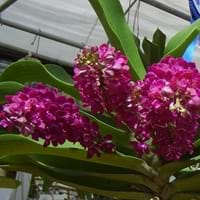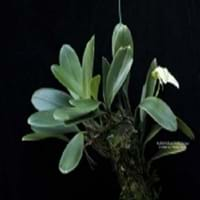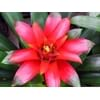Life Span
Perennial
Perennial
Origin
World/Pandemic
Southeastern Asia
Types
Rhynchostylis gigantea (Red), Rhynchostylis gigantea (Chang Ply type)
Bulbophyllum grandiflorum
Habitat
Coastal Regions
Humid climates, Well Drained
USDA Hardiness Zone
13-15
11-15
AHS Heat Zone
12-10
12-10
Habit
Clump-Forming
Clump-Forming
Flower Color
White, Lavender, Violet, Plum
White, Gold, Light Green, Tan
Flower Color Modifier
Bicolor
Bicolor
Fruit Color
Not Available
Not Available
Leaf Color in Spring
Green
Green, Light Green
Leaf Color in Summer
Green
Green, Light Green
Leaf Color in Fall
Green
Green, Light Green
Leaf Color in Winter
Green
Green, Light Green
Leaf Shape
Long Linear
Ovate
Plant Season
Fall, Winter
Fall
Sunlight
Partial Sun, Partial shade
Partial Sun, Partial shade
Type of Soil
Not Available
Not Available
The pH of Soil
Not Available
Not Available
Soil Drainage
Well drained
Well drained
Bloom Time
Early Fall, Fall, Late Fall, Early Winter
Early Fall, Fall, Late Fall
Tolerances
Not Available
Not Available
Where to Plant?
Container, Ground, Pot
Container, Ground, Pot
How to Plant?
Divison
Cuttings, Seedlings
Plant Maintenance
Medium
Medium
Watering Requirements
Keep ground moist, Over-watering can cause leaf problems or root diseases
Keep ground moist, Keep the ground moist but not water-logged
In Summer
Moderate
Lots of watering
In Spring
Ample Water
Moderate
In Winter
Average Water
Average Water
Soil pH
Not Available
Not Available
Soil Type
Not Available
Not Available
Soil Drainage Capacity
Well drained
Well drained
Sun Exposure
Partial Sun, Partial shade
Partial Sun, Partial shade
Pruning
Remove dead branches
Prune lower leaves, Remove damaged leaves, Remove dead branches, Remove dead leaves, Remove dead or diseased plant parts
Fertilizers
Fertilize once a week in winter
All-Purpose Liquid Fertilizer, Water soluble fertilizers
Pests and Diseases
Not Available, Red blotch
Red blotch
Plant Tolerance
Not Available
Not Available
Flower Petal Number
Single
Single
Foliage Texture
Coarse
Coarse
Foliage Sheen
Matte
Matte
Attracts
Not Available
Not Available
Allergy
Not Available
Not Available
Aesthetic Uses
Beautification, Bouquets, Showy Purposes
Showy Purposes
Beauty Benefits
Not Available
Not Available
Edible Uses
No
Insignificant
Environmental Uses
Air purification
Air purification
Medicinal Uses
Not Available
Not Available
Part of Plant Used
Flowers
Not Available
Other Uses
Oil is used for aromatherapy
Used as Ornamental plant
Used As Indoor Plant
No
No
Used As Outdoor Plant
Yes
Yes
Garden Design
Container, Feature Plant, Houseplant, Mixed Border
Container, Feature Plant, Hanging Basket, Houseplant, Tropical
Botanical Name
RHYNCHOSTYLIS gigantea
BULBOPHYLLUM burfordiense
Common Name
Orchid, Rhynchostylis
Bulbophyllum, Orchid
In Hindi
कोपु फूल
Bulbophyllum
plant
In German
Rhynchostylis Gigantea
Bulbophyllum
Pflanze
In French
Rhynchostylis Gigantea
Bulbophyllum
plante
In Spanish
Rhynchostylis Gigantea
bulbophyllum
planta
In Greek
Rhynchostylis Gigantea
βολβόφυλλο
φυτό
In Portuguese
Rhynchostylis Gigantea
Bulbophyllum
plantar
In Polish
Rhynchostylis Gigantea
Bulbophyllum
roślina
In Latin
Rhynchostylis Gigantea
Bulbophyllum
herba
Phylum
Tracheophyta
Magnoliophyta
Class
Liliopsida
Liliopsida
Order
Asparagales
Asparagales
Family
Orchidaceae
Orchidaceae
Genus
Rhynchostylis
Bulbophyllum
Clade
Angiosperms, Monocots
Not Available
Tribe
Not Available
Podochileae
Subfamily
Not Available
Epidendroideae
Number of Species
Not Available
Properties of Rhynchostylis Gigantea and Bulbophyllum
Wondering what are the properties of Rhynchostylis Gigantea and Bulbophyllum? We provide you with everything About Rhynchostylis Gigantea and Bulbophyllum. Rhynchostylis Gigantea doesn't have thorns and Bulbophyllum doesn't have thorns. Also Rhynchostylis Gigantea does not have fragrant flowers. Rhynchostylis Gigantea has allergic reactions like Not Available and Bulbophyllum has allergic reactions like Not Available. Compare all the properties and characteristics of these two plants. Find out which of these plant can be used as indoor plant. If you are interested to decorate your house and garden, find out aesthetic uses, compare them and select the plant which will beautify your surrounding. Along with beautification, try comparing medicinal and edible uses of Rhynchostylis Gigantea and Bulbophyllum and you can choose the plant having best and most benefits.
Season and Care of Rhynchostylis Gigantea and Bulbophyllum
Season and care of Rhynchostylis Gigantea and Bulbophyllum is important to know. While considering everything about Rhynchostylis Gigantea and Bulbophyllum Care, growing season is an essential factor. Rhynchostylis Gigantea season is Fall and Winter and Bulbophyllum season is Fall and Winter. The type of soil for Rhynchostylis Gigantea is Not Available and for Bulbophyllum is Not Available while the PH of soil for Rhynchostylis Gigantea is Not Available and for Bulbophyllum is Not Available.
Rhynchostylis Gigantea and Bulbophyllum Physical Information
Rhynchostylis Gigantea and Bulbophyllum physical information is very important for comparison. Rhynchostylis Gigantea height is 40.60 cm and width 50.80 cm whereas Bulbophyllum height is 35.60 cm and width 40.60 cm. The color specification of Rhynchostylis Gigantea and Bulbophyllum are as follows:
Rhynchostylis Gigantea flower color: White, Lavender, Violet and Plum
Rhynchostylis Gigantea leaf color: Green
Bulbophyllum flower color: White, Gold, Light Green and Tan
- Bulbophyllum leaf color: Green and Light Green
Care of Rhynchostylis Gigantea and Bulbophyllum
Care of Rhynchostylis Gigantea and Bulbophyllum include pruning, fertilizers, watering etc. Rhynchostylis Gigantea pruning is done Remove dead branches and Bulbophyllum pruning is done Prune lower leaves, Remove damaged leaves, Remove dead branches, Remove dead leaves and Remove dead or diseased plant parts. In summer Rhynchostylis Gigantea needs Moderate and in winter, it needs Average Water. Whereas, in summer Bulbophyllum needs Lots of watering and in winter, it needs Average Water.





